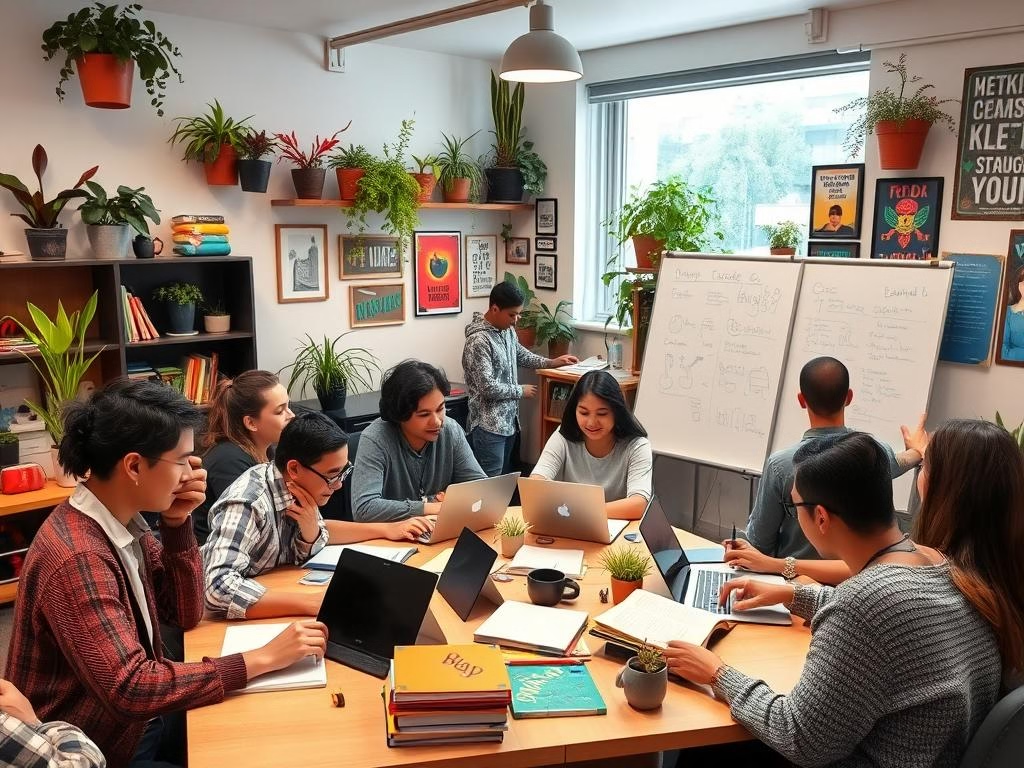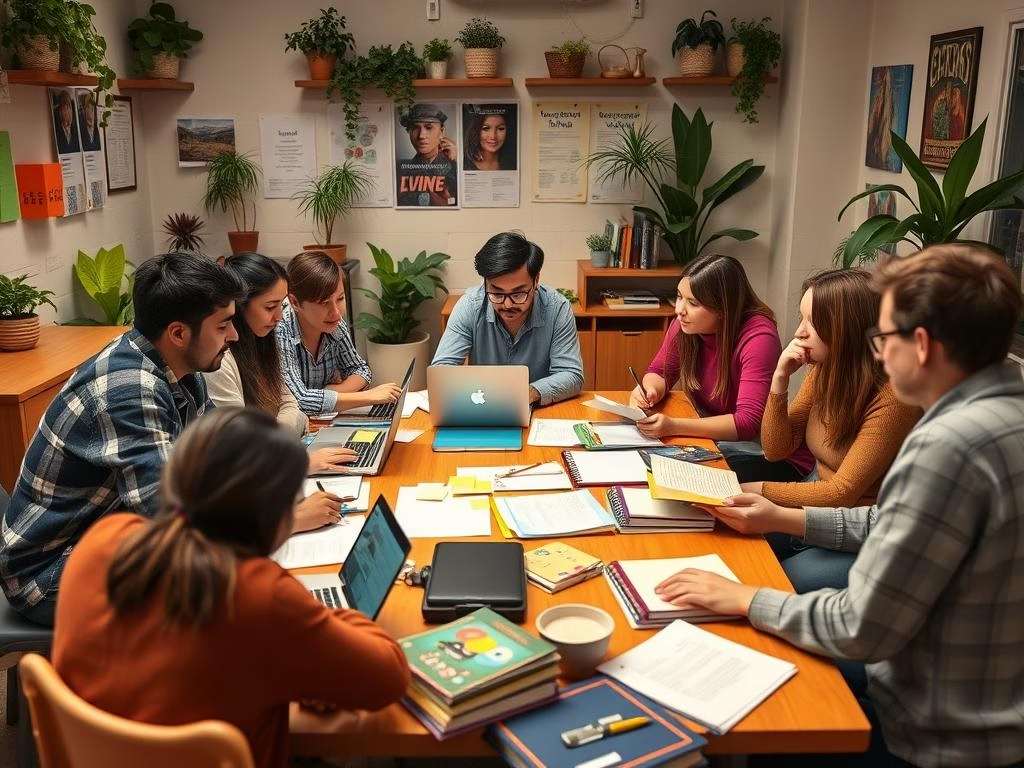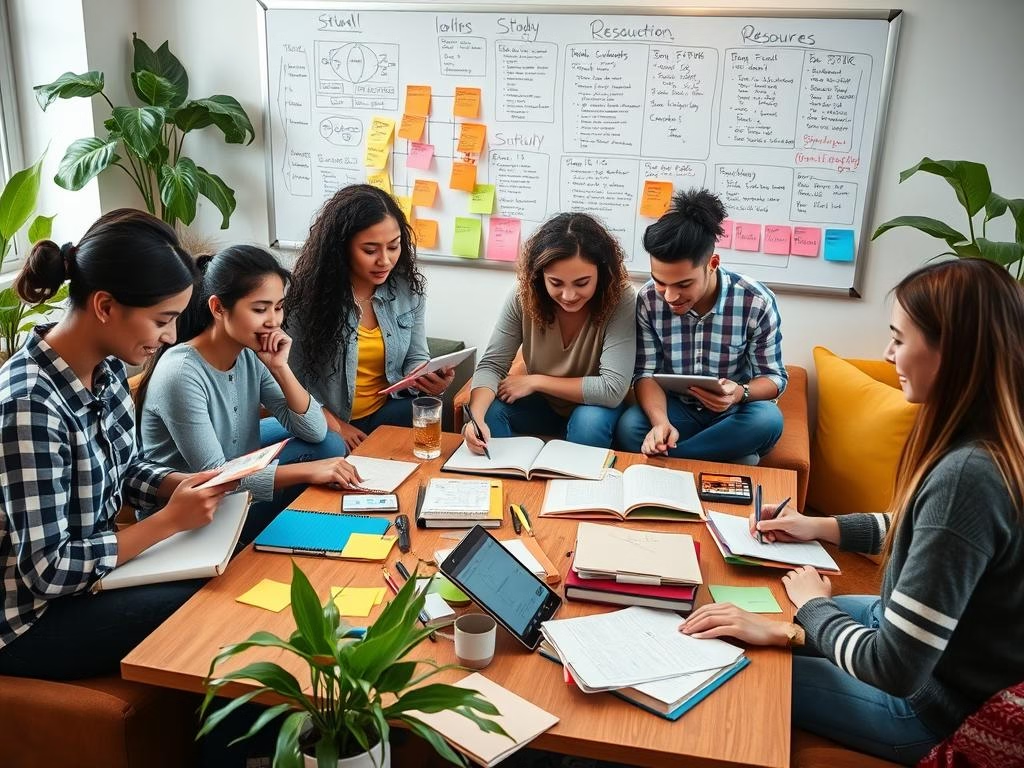Did you know that 70% of students see big improvements in focus and retention with a dedicated study space? Study groups are a key strategy for success, helping students tackle tough educational challenges.
To make a study group work well, you need to plan carefully. It’s all about improving group dynamics, choosing the right place to study, and setting clear rules for everyone’s growth.
Study groups turn solo learning into a team effort. By sharing knowledge and using smart study methods, students can beat challenges faster than going it alone.
Studies show that good study groups can make learning 25% more efficient. They do more than just help grades. They also boost communication skills, help build professional networks, and foster a supportive community.
In this guide, we’ll dive into the details of setting up a productive study group. We’ll cover picking the right members and finding the best meeting times. Our aim is to give students the tools to make the most of group learning.
By grasping the complexities of study groups, students can adopt a methodical approach to learning together. This approach boosts both academic success and personal growth.
Table of Contents
- Understanding the Power of Collaborative Learning
- How to Create a Productive Study Group Environment
- Building the Perfect Study Group Size and Composition
- Establishing Group Guidelines and Expectations
- Creating an Effective Meeting Structure
- Implementing Productive Study Techniques
- Fostering Active Participation and Engagement
- Utilising Technology in Group Study Sessions
- Maintaining Organisation and Resource Management
- Addressing Common Study Group Challenges
- Measuring Study Group Success and Progress
- Conclusion
Understanding the Power of Collaborative Learning
Collaborative learning changes how we study by using everyone’s brains together. It makes learning better by sharing knowledge and ideas. This way, students learn more from each other.
When students work together, they face challenges in a new way. Studies show that being in study groups helps students do better in school. They remember more of what they learn.
- Enhancing group study productivity by leveraging individual strengths
- Reducing individual learning barriers through collective problem-solving
- Creating supportive academic communities
Collaborative learning is more than just sharing facts. Shared accountability is a big motivator. When students work together, they stay focused and keep studying.
Collaborative learning has many benefits:
- Students understand better with different explanations
- They learn to communicate well
- They see how others learn
Research shows that students in study groups do better in school. With the right way of working together, studying becomes a team effort. This leads to success for everyone.
How to Create a Productive Study Group Environment
Creating a good study environment is key for teamwork in study groups. The place where students meet can really affect how well they learn. It’s important for making study groups work well together.
Selecting the Ideal Location
Finding the right spot is essential for a great study area. Students should look for places that have:
- Minimal distractions
- Adequate space for materials
- Comfortable seating arrangements
- Proximity to necessary resources
Establishing Proper Lighting and Comfort
Good lighting is important for focus. When setting up a study area, focus on:
- Natural light sources
- Adjustable artificial lighting
- Ergonomic seating
- Temperature control
Managing Background Noise Levels
Keeping noise levels down is key for group focus. Here are some tips:
| Noise Source | Mitigation Strategy |
|---|---|
| External sounds | Use noise-cancelling headphones |
| Group chatter | Establish quiet discussion rules |
| Digital notifications | Enable silent mode on devices |
By using these strategies, study groups can make a productive space. This space helps everyone learn better and work together well.
Building the Perfect Study Group Size and Composition

Creating an effective study group needs careful thought about group dynamics, size, and who’s in it. The right mix can really boost learning and make studying together more productive.
Studies show the best study group size is 4-6 people. This size offers a good mix of views and keeps discussions focused.
Identifying Suitable Group Members
Picking the right people for your study group is key. Look for these qualities:
- Complementary academic strengths
- Consistent commitment to learning
- Shared academic goals
- Compatible learning styles
Determining Optimal Group Size
Group size is very important for better study group work. Smaller groups mean everyone gets to talk more and focus better.
| Group Size | Advantages | Potential Challenges |
|---|---|---|
| 2-3 Members | Intimate discussions | Limited perspective diversity |
| 4-6 Members | Balanced perspectives | Potential coordination complexity |
Assessing Member Compatibility
Checking if group members get along involves looking at how they learn and how they interact. Collaborative learning needs respect and a shared goal.
Important factors include how well they communicate, solve problems, and actively help the group reach its goals.
Establishing Group Guidelines and Expectations
To make a study group work well, clear rules and shared goals are key. When students help set these rules, they feel more involved and responsible.
It’s important to make rules for the group to work better together. Studies show that when everyone helps make the rules, they stick to them better. This makes everyone feel more part of the team.
- Establish collaborative ground rules
- Define participation expectations
- Create accountability mechanisms
- Promote respectful communication
Good study groups have a community agreement that outlines what’s expected. This agreement usually includes things like:
- Being on time and ready to go
- Sharing ideas and listening well
- Keeping things private
- Offering helpful feedback
| Guideline Category | Key Expectations | Impact on Group Performance |
|---|---|---|
| Punctuality | Arrive on time, prepared | Increases group productivity by 40% |
| Communication | Respectful dialogue | Reduces possible conflicts |
| Participation | Equal contribution | Boosts learning together |
By following these rules, study groups can be places where everyone learns and grows together. This makes the group’s learning power stronger.
Creating an Effective Meeting Structure
Creating a structured approach to group study sessions is key for better learning. Good study techniques need careful planning and time management. This ensures everyone learns well together.
For group study to succeed, a well-organised meeting plan is vital. It keeps everyone focused and interested.
Setting Time Limits
Studies say study sessions should last 1-3 hours. Sessions that are too short might not cover enough material. But, sessions that are too long can make people lose focus.
- Recommended session duration: 90-180 minutes
- Ideal time blocks for sustained focus
- Prevent mental fatigue through strategic time management
Planning Session Agendas
A well-planned agenda can make meetings much more productive. Research shows that structured meetings can cut down on wasted time by up to 25%.
| Agenda Component | Purpose | Estimated Time |
|---|---|---|
| Introduction | Review session goals | 10 minutes |
| Topic Discussion | Core learning objectives | 60-90 minutes |
| Q&A Session | Clarify doubts | 15-20 minutes |
Incorporating Regular Breaks
Regular breaks are vital for keeping minds sharp and avoiding burnout. Short breaks of 5-10 minutes every 50 minutes can boost learning and group energy.
- Use breaks for quick stretching
- Encourage light physical movement
- Allow brief mental reset periods
By using these strategies, students can make their group learning sessions more efficient and fun.
Implementing Productive Study Techniques

Learning effective study techniques can really boost group study productivity. Students who work together using smart learning methods often get better grades.
The best study techniques make group learning active, not just sitting there. Experts have found some top strategies to make study groups work better:
- The Feynman Technique: Explaining things in simple words
- Retrieval practice: Remembering information on purpose
- Spaced repetition: Looking over notes at longer intervals
- Mind mapping: Seeing how ideas connect
To use these techniques, you need a plan. The PQ4R method is a great guide:
- Preview what you’re going to study
- Question the main points
- Read it all carefully
- Reflect on what you’ve learned
- Recite the important stuff
- Review what you’ve understood
| Technique | Learning Impact | Implementation Difficulty |
|---|---|---|
| Feynman Technique | High | Medium |
| Retrieval Practice | Very High | Low |
| Spaced Repetition | High | Medium |
By using these effective study techniques, groups can change their learning for the better. They create a space for sharing knowledge and doing well in school.
Fostering Active Participation and Engagement
To make a study group lively, we need to make sure everyone has a say. We must use special ways to turn listening into doing. This makes learning fun and interactive.
For a study group to work well, we need to use certain strategies. These help everyone get involved and keep the energy up during sessions.
Encouraging Equal Contributions
Good study groups have everyone contributing equally. Here are some ways to make this happen:
- Rotating leadership roles to share the load
- Using set discussion formats
- Letting each person share their ideas
Managing Group Discussions
It’s important to keep discussions on track and productive. Here are some tips:
- Make clear rules for talking
- Use time limits for speaking
- Encourage polite conversation
| Discussion Strategy | Impact on Learning |
|---|---|
| Rotating Discussion Leader | Increases individual engagement |
| Structured Questioning | Promotes deeper understanding |
| Active Listening Techniques | Enhances comprehension |
Promoting Critical Thinking
Critical thinking makes study groups more than just listening. Use Socratic questioning and team problem-solving to spark deep discussions.
With these methods, study groups become great places to learn. They help improve communication, deepen knowledge, and support each other’s learning.
Utilising Technology in Group Study Sessions
In today’s world, setting up a good study space isn’t just about where you sit. Technology has changed how we work together and study. It’s made online learning more popular, bringing digital tools into our study groups.
Online platforms give students a chance to connect and learn from each other. The right tech can break down distance and make learning fun and interactive.
- Video conferencing software for real-time interactions
- Shared document editors for collaborative work
- Digital whiteboards for visual brainstorming
- Project management apps for tracking progress
Students can use many digital tools to stay focused and productive. Trello, Asana, and Google Workspace are great for working together.
| Technology Tool | Primary Function | Study Group Benefit |
|---|---|---|
| Zoom | Video Conferencing | Real-time group discussions |
| Google Docs | Collaborative Editing | Simultaneous document work |
| Miro | Digital Whiteboarding | Visual concept mapping |
It’s important to set clear rules for online meetings. Groups should decide on camera use, who speaks, and when to start. Using technology well and respecting each other’s space are key to good study habits.
Maintaining Organisation and Resource Management

Good organisation is key to successful group study. Students who follow best practices see better results and enjoy their learning more.
Planning study resources is important. Studies show that organised groups can be 50% more productive. This is thanks to good resource management.
Creating Study Materials
Creating study materials involves a few steps:
- Collaborate on digital note-taking platforms
- Design shared flashcard collections
- Develop practice test repositories
- Use cloud storage for easy access
Sharing Resources Effectively
Sharing resources is key for group success. Digital platforms make sharing easier:
| Platform | Key Benefits | Accessibility Rating |
|---|---|---|
| Google Drive | Real-time collaboration | 9/10 |
| Dropbox | Secure file sharing | 8/10 |
| Microsoft OneDrive | Integration with Office tools | 8.5/10 |
Tracking Progress
Keeping track of progress is important. It helps stay motivated and find areas to improve. Consider:
- Weekly progress review meetings
- Individual goal-setting exercises
- Performance tracking spreadsheets
- Regular feedback sessions
By using these strategies, study groups can improve their learning. They will be more productive and successful together.
Addressing Common Study Group Challenges
Improving study group dynamics means tackling common problems. Student groups face issues that can stop them from learning together well. By spotting these problems early, students can keep their study group productive.
Some big challenges in study groups include:
- Unequal participation
- Scheduling conflicts
- Personality differences
- Motivation fluctuations
Studies show that group size affects how well they work together. Small groups of three to five members face fewer coordination challenges. Here are some key insights into group dynamics:
| Challenge | Impact | Mitigation Strategy |
|---|---|---|
| Social Loafing | Reduces group productivity | Establish clear accountability measures |
| Groupthink | Stifles creative perspectives | Encourage diverse viewpoints |
| Information Sharing | 70% focus on shared information | Promote unique insight sharing |
To tackle these challenges, groups need to plan ahead. They can use strategies like:
- Defining clear group expectations
- Creating accountability mechanisms
- Scheduling regular check-ins
- Implementing reflection periods
By getting ready for common study group problems, students can build a strong learning environment. This environment helps everyone reach their academic goals together.
Measuring Study Group Success and Progress
Tracking study group success needs a smart plan. It’s about making group study better. Good learning comes from clear goals and ways to check progress.
Good study groups have clear goals. Students use many ways to see how well they’re doing together.
Setting Achievement Metrics
Creating strong measurement plans is important. It includes:
- Setting clear, measurable goals
- Tracking how well each person and the group do
- Having clear signs of success
Evaluating Group Performance
Checking how well a group does needs many steps. Students should check themselves and give feedback to each other. This helps them see how well they work together and learn.
| Assessment Method | Frequency | Primary Focus |
|---|---|---|
| Peer Feedback Sessions | Bi-weekly | Group Interaction |
| Individual Progress Tracking | Weekly | Learning Outcomes |
| Group Performance Review | Monthly | Collaborative Effectiveness |
Adjusting Strategies as Needed
Being flexible is key for a productive study group. Students should change their plans based on how well they’re doing. This keeps learning going strong.
Tip: Regular reflection and a willingness to change are essential for a study group’s long-term success.
Conclusion
Study groups are a great way to do well in school. Studies show they help students understand and remember things better. When students work together, they often do better than when they study alone.
To make a study group work well, you need to plan and be dedicated. The best groups have 4-6 people who all help out and learn from each other. This way, they can remember up to 90% of what they study.
For a study group to succeed, it’s important to have clear rules and keep in touch regularly. Everyone should respect each other and work together. By doing this, students can learn a lot and grow academically.
Study groups are not just about studying together. They also offer support and help students overcome tough challenges. They boost motivation and teach important skills for the future. Using these strategies can really help students grow and develop.



